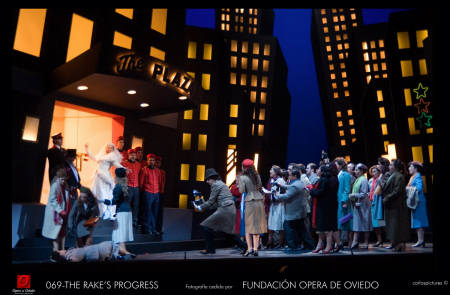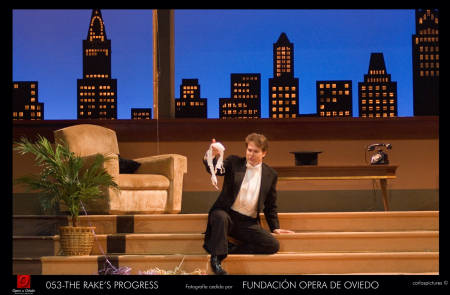Other Links
Editorial Board
- Editor - Bill Kenny
Founder - Len Mullenger
Google Site Search
SEEN
AND HEARD INTERNATIONAL OPERA REVIEW
Stravinsky, The Rake’s Progress:
Soloists,
Oviedo Filarmonía. Coro de la Ópera de Oviedo, Conductor: Mikhail
Agrest. Teatro Campoamor de Oviedo. 27.11.2008. (JMI)
Production from Théatre des Champs Elysées.
Director. André Engel.
Sets: Nicky Rieti.
Costumes: Chantal de la Coste.
Lighting: André Diot.
Cast:
Tom
Rakewell: Marlin Miller.
Anne Truelove: Elizabeth Futral.
Nick Shadow: Chester Patton.
Baba the Turk: Dagmar Peckova.
Mother Goose: Rebecca de Pont Davies.
Truelove: Darren Jeffery.
Sellem: Francisco Vas.

Little by little Oviedo is revising the
repertoire in its opera season, introducing some rather rare titles
to Spain. In the current season they have presented already two
operas composed during the second half of the last century,
Poulenc’s Dialogues des Carmelites and now The Rake’s
Progress. Both works are fundamentals in the history of
opera, although remaining not be particularly attractive to the
general public.. This is the great dilemma that any programmer has
to face: to find the balance between the traditional preferences of
the public in general and the necessity to open up repertoire by
offering important operas, even though they are not necessarily
popular. Oviedo, like some other theatres in Spain, is struggling to
find an equilibrium and basically they are succeeding.
The Rake’s Progress is probably Stravinsky’s best known opera
and its last performance in Spain took place two years ago at the
Mozart Festival in Corunna. Prior to this we have to go back to
Madrid’s Teatro de la Zarzuela in 1996. The work, as many will
surely know, is inspired by the collection of eight pictures by the
18th century English painter William Hogarth, a
collection from which the opera takes its title and which can still
be seen today at the Sir John Soane Museum in London. The opera is
essentially a very classical work, Mozart’s model to a great extent
although not lacking music derived from jazz and even with some
fanfares at the work’s beginning very calling Monteverdi’s Orfeo
toi mind. Also it include a final scene about the spelling out a
moral, a common practice in opera at the end of 18th
century and in the first half of 19th.
The production by the French
director André Engel comes from the
Theatre Des Champs Elysées, where it was premiered in 2001 and was
revived again last year. Engel – with good sense - transfers the
action from 18th century England to the late 50s in
America, which is in line with the composer’s own conception of it,
since he had the idea from an exhibition in a Chicago Museum and
composed the opera in the US, for its premiere in 1951. The sets
are very appropriate, bright and colourful at certain moments and
just trying to tell a story in others. Particularly well conceived
are the scenes in the cabaret, the wedding with the Baba the Turk
and the madhouse scene. There are bright costumes too and
outstanding lighting in general. Engel does not follow today’s
custom of having one single set for the whole opera, but changes
sets for different scenes, making very good use of the front curtain
and having some singing in front of it to allow the change of sets
behind. Stage direction is good both with chorus and singers, with
alternating humorous moments and others of
deep sadness. As the program points out,
Stravinsky wrote - that the stage director should remember that this
opera is a moral fable and so should not over-emphasize the realism
of Tom Rakewell’s history. Luckily André Engel has respected the
composer’s view: a huge surprise these days! It is a curious
coincidence that there is another Rake’s Progress, in Vienna
just now by Martin Kunsej, in which the “realism” has obliged the
management prohibit entrance to young people under 18.
Mikhail Agrest, a regular collaborator with Valery Gergiev at the
Mariinsky Theater, was in charge of the Musical Direction and gave
a remarkable performance. His direction was very careful, and could
have sparkled aarather more sometimes, but the Orchestra played at
a higher standard than usual The chorus is a group of people able
to sing well and act well having improved a great deal in the last
two years. In summary, this was a good choice of conductor.

The
protagonist Tom Rakewell was the American tenor Marlin Miller, who
was very well suited to the needs of the character. His voice is
not exactly beautiful but he is a good singer who moves easily on
stage.
Nick Shadow, a kind of Mephistopheles, found a good interpreter in
the American bass baritone Chester
Patton, far better suited to this role than he was to Enrico VIII
in Anna Bolena last year in Bilbao. He offered a remarkable
interpretation, with a physical presence exactly suited to the role.
In vocal terms he was also excellent, except for some high notes of
less than outstanding quality.
American soprano Elizabeth Futral made a wonderful Anne Truelove.
She replaced the previously announced Mary Dunleavy and this is one
of the few times where the replacement actually improved the
performance. Ms. Futral is one of the most appreciated light lyric
sopranos around these days: she was also excellent and was always a
believable interpreter of the role, at her best in the best known
aria from the opera “No word from Tom”.
The most inventive character in the opera, Baba The Turk, was
interpreted with not quite enough voice by Dagmar Peckova, who was
almost inaudible for too much of the time. Essentially, . the
problem was that the role requires a sonorous contralto and
this Czech singer is not that.
In the secondary roles, the best interpretation came from Francisco
Vas as Sellem, the auctioneer, who was very good in all the senses.
Rebecca De Pont Davies was a decent Mother Goose, the Madame of
the brothel and Darren Jeffery was a modest Truelove.
There was a full theatre as usual in Oviedo. The audience seemed
pleased, although not excited and at the final bows the biggest
applauses went to Elizabeth Futral and Charles Patton.
José M. Irurzun
Pictures © Carlos Pictures
Back
to Top
Cumulative Index Page
